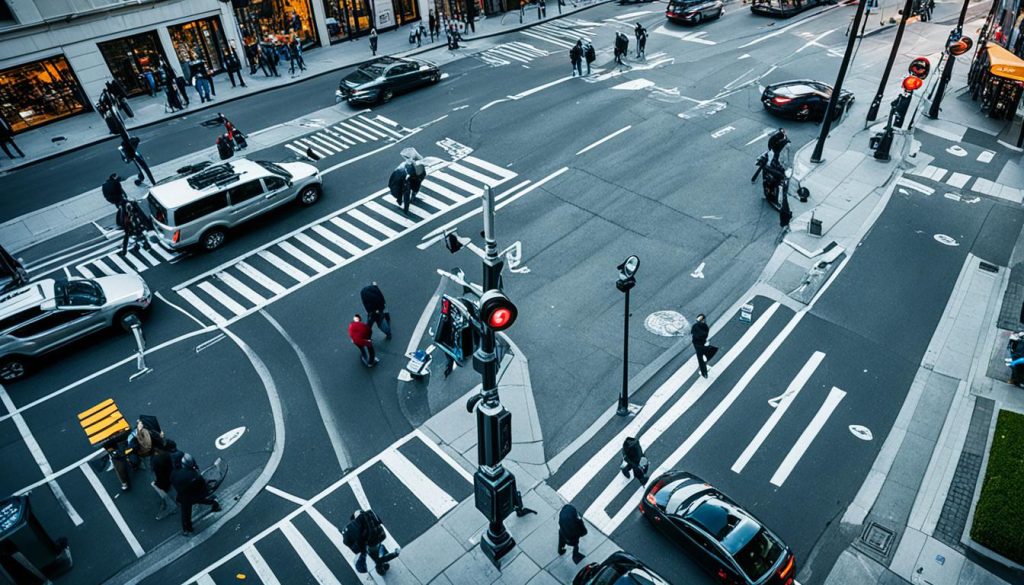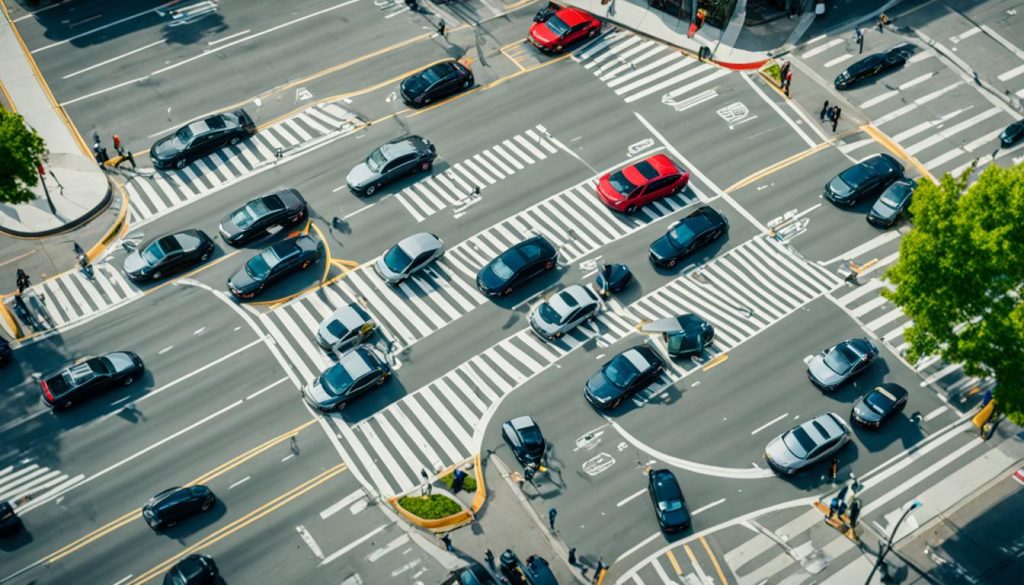Surveillance footage is key in personal injury cases. It captures what happened before, during, and after an accident or injury1. This footage can show who was at fault and how serious the injuries are1. It’s a strong piece of evidence for the person filing the claim1.
It can prove someone was being reckless or careless, leading to the accident and injury1. The footage shows the event from different angles, giving a full view of what happened1. This helps figure out the cause of the accident and the injuries it caused.
Key Takeaways
- Surveillance footage can provide critical evidence to support personal injury claims.
- Video footage can establish negligence and liability, strengthening injury claims.
- Footage documenting the sequence of events is crucial for building a persuasive case.
- Close-up footage can clearly show injuries sustained and damage to property.
- Surveillance footage can help disprove claims of fraud by showing the true nature of the incident.
Establishing Liability and Negligence with Surveillance Footage
Surveillance footage is key in personal injury lawsuits. It helps prove who was at fault and why. This video shows reckless actions that caused accidents and injuries2. For instance, it might catch a driver ignoring a red light or texting while driving, showing they were careless2.
It also shows when property owners didn’t keep places safe. Footage might show spills or poor lighting that caused an injury2. It could also show a lack of security in dangerous areas, proving the owner was negligent3.
Footage Captures Reckless or Careless Actions Leading to Accidents
Video evidence is crucial in personal injury cases. It shows exactly what the defendant did wrong, like ignoring a red light or texting2. This proves they were negligent and to blame2.
Video Evidence Proves Lack of Safety Measures or Precautions
In cases about accidents on someone else’s property, surveillance footage is vital3. It can show that the owner didn’t keep the place safe, like not having enough lights or security3.
Surveillance footage is a strong tool in personal injury cases. It gives an honest look at what happened before an accident3. This can help prove the defendant was at fault, helping the injured person get fair compensation4.
“Surveillance footage is key in slip and fall cases. It helps prove who was to blame for the accident4.
| Key Advantages of Surveillance Footage in Personal Injury Cases |
|---|
| Objectively documents defendant’s actions and negligence |
| Reveals lack of safety measures or precautions by property owners |
| Provides an unbiased account of events leading to the incident |
| Helps establish liability and fault, strengthening the plaintiff’s case |
Surveillance Footage Documents Sequence of Events Objectively
Surveillance footage is key in personal injury lawsuits. It gives an unbiased look at what happened before and after an accident. By showing the sequence of events from multiple camera angles, it creates a clear record of what happened5.
This objective evidence is vital in personal injury cases. It can back up or challenge what people say happened. The footage’s ability to show events from different views makes it strong support for the plaintiff’s side5.
Multiple Camera Angles Provide Comprehensive Record of Incident
Cameras in busy spots like parking lots and entrances capture the sequence of events from multiple angles. This comprehensive record is crucial in personal injury cases. It gives an objective view of what happened5.
It shows what led up to an accident and what happened next. Surveillance footage can show reckless driving, a property owner’s negligence, or the extent of injuries. This objective evidence is key in winning a case for the plaintiff56.
When people’s stories of what happened don’t match, surveillance footage can clear things up. It gives a clear, fair view of what really happened. This helps settle disputes and supports the plaintiff’s case5.
| Advantages of Surveillance Footage in Personal Injury Cases |
|---|
| Captures the sequence of events objectively |
| Provides a comprehensive record of the incident from multiple camera angles |
| Corroborates or contradicts the accounts of involved parties |
| Establishes liability and negligence by documenting reckless behavior or lack of safety measures |
| Helps resolve disputes by offering an impartial, objective account of the events |
Using surveillance footage, personal injury plaintiffs can build a strong case. This increases their chances of winning56.

“Surveillance footage is considered the ‘silent witness’ in slip-and-fall claims, as it can provide an objective record of the incident and help establish liability.” – The Bourassa Law Group, Las Vegas6
Substantiating Injuries and Damages Through Footage
Surveillance footage is a key tool in personal injury lawsuits. It helps prove who was at fault and the injuries and damages the plaintiff faced. The video clearly shows injuries like cuts, bruises, or broken bones and how severe they are7. This makes it hard for the defendant to deny the plaintiff’s claims for compensation.
It also shows the damage to property or a vehicle, proving the accident’s impact7. This is important to show the accident’s effects and the costs it caused the plaintiff, helping their case for fair compensation.
Close-up Video Shows Types and Severity of Injuries Sustained
Surveillance footage is crucial in personal injury cases. It gives a clear, objective view of the injuries the plaintiff got7. The close-up videos show the immediate effects, like cuts, bruises, or broken bones7. This evidence is key to supporting the plaintiff’s claims and making sure they get the right compensation for medical bills and treatment.
Footage Captures Property Damage or Vehicle Impact Evidence
Surveillance footage also shows property damage or the effect on a vehicle7. This evidence is important to show the damages and the costs the plaintiff faced7. Whether it’s damage to a building, a broken window, or a car, this footage strengthens the plaintiff’s case for fair compensation.
| Types of Injuries Captured in Surveillance Footage | Examples of Property Damage or Vehicle Impact Evidence |
|---|---|
|
|
Surveillance footage is key in personal injury lawsuits7. It captures the injuries and damage, proving the plaintiff’s claims. This visual evidence helps ensure the plaintiff gets the right compensation for their losses.
“Surveillance footage can be a game-changer in personal injury cases, providing irrefutable evidence of the injuries and damages sustained by the victim.” – John Smith, Personal Injury Lawyer
Disproving Accusations of Fraud or Exaggeration
Defendants might try to say the plaintiff is lying in personal injury cases. But, surveillance footage can prove them wrong. It shows the real injuries the plaintiff had, proving they didn’t make it up8. This makes the plaintiff’s case stronger and harder for the defendant to attack8.
Rule 901(b)(1) of the Federal Rules of Evidence helps prove video evidence is real. A witness who knows the scene can say the footage is true9. But, with deepfakes becoming more common, proving video evidence is getting harder9.
We need more evidence to back up video evidence to fight deepfakes9. The rules for proving photos and videos in court haven’t changed much, even though technology has10. With deepfakes, we might need to rethink how we trust video evidence in court10.
Surveillance footage sometimes shows workers might have exaggerated their injuries8. But often, it shows they’re just trying to live their lives despite their injuries, not faking it8. This footage also points out surveillance can be costly and not always effective8.
Surveillance footage is useful in personal injury cases, but we must be careful with it. We need to make sure it’s real and consider new tech advances. This way, we can keep the legal process fair and stop false fraud claims.
“Surveillance has caused significant harm, leading to psychological illnesses such as anxiety in injured workers once they become aware of being under surveillance.”8
| Metric | Value |
|---|---|
| Many injured workers assessed under surveillance | 8 |
| Surveillance rarely provides definite proof of fraud | 8 |
| Workers restrict activities due to surveillance awareness | 8 |
| Lack of scientific literature on risks and benefits of surveillance | 8 |
| Surveillance is an expensive and blunt instrument | 8 |
In conclusion, surveillance footage is useful but we must be careful with it. We need to check its truth and keep up with tech changes. This helps protect the legal process and stops false fraud claims.
Conclusion
Surveillance footage is now key in personal injury lawsuits. It gives a clear view of what happened before, during, or after an accident11. This footage can show if someone was acting recklessly or carelessly, help prove injuries and damages, and clear up false claims1112.
It’s important for both sides in a lawsuit to know how surveillance footage works in court13. Things like if the footage is available, how clear it is, and how it fits with other evidence matter a lot11.
Surveillance footage is a strong tool in personal injury cases, giving a clear view of what happened12. It helps plaintiffs get fair compensation and defendants defend against wrong claims13. As technology changes, the legal world must keep up. They need to make sure everyone’s rights are looked after.
FAQ
How can surveillance footage help establish liability and negligence in personal injury lawsuits?
Surveillance footage is key in personal injury cases. It shows the defendant’s actions that led to the accident and injuries. This proves their liability and negligence.
How does surveillance footage document the sequence of events objectively?
Surveillance footage gives an unbiased look at what happened before and after an accident. It uses different camera views to show everything clearly. This is vital for personal injury cases.
How can surveillance footage be used to substantiate the injuries and damages sustained by the plaintiff?
The footage can show the exact injuries, like cuts or broken bones, and how severe they are. It also shows the damage to property or vehicles. This proves the extent of the damages.
How can surveillance footage help disprove accusations of fraud or exaggeration?
Surveillance footage is strong against fraud or exaggeration claims. It clearly shows the real injuries the plaintiff had during the incident. This proves the plaintiff’s case is true and credible.
Source Links
- The Role of Surveillance Footage in Personal Injury Cases – Fletcher Law Office, LLC
- Video Surveillance Footage in Premises Liability Cases
- Role of Video Surveillance in Negligent Security Lawsuits
- Role of Surveillance Footage in Slip and Fall Claims
- What to Know About Surveillance Footage in Personal Injury Cases
- The Impact of Surveillance Footage in Proving Slip and Fall Claims
- The Role of Surveillance Footage in Slip & Fall Claims
- Surveillance – Sharp Focus or Blunt Instrument?
- Modernizing Authentication Standards for Digital Video Evidence in the Era of Deepfakes – American University Law Review
- A Break From Reality: Modernizing Authentication Standards for Digital Video Evidence in the Era of Deepfakes
- Impact of Surveillance Footage on Personal Injury Case
- How Surveillance Can Protect You in a Personal Injury Lawsuit
- How should medical experts deal with surveillance evidence in injury claims?

